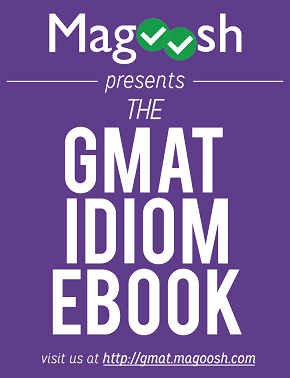
Maybe you’re struggling with GMAT Verbal or maybe English isn’t your first language—or maybe both. In either case, you’re likely struggling with GMAT idioms. With that in mind, Magoosh is thrilled to present our free FREE Magoosh GMAT Idiom eBook. This eBook includes comprehensive lists, detailed explanations, and examples of 27 different types of GMAT idioms: idioms involving prepositions, conjunctions, infinitives, comparison, and many many more! All written by our resident GMAT grammar expert, Mike McGarry :).
GMAT Idioms: What You Need to Know
What are idioms?
Idioms are idiomatic expressions: unique combinations of words or words that always “belong together” in the English language. Sometimes, an idiom can be a common expression like “raining cats and dogs”—but this is NOT the type of idiom you’ll see in the context of the GMAT exam! Instead, common GMAT idiom questions are more subtle: you’ll encounter idioms like “ability to do” or “prevent from doing.”
Overall, the GMAT will be testing your knowledge of idioms in several ways: from the correct use of a specific preposition to word order to forms of comparison, or a specific grammar rule. In other words, your job will be to identify incorrect usage, then identify the correct idiom in the right answer!
How important are they for GMAT sentence correction?
Idiom questions are a common question type on the GMAT. They appear just as frequently as parallelism so… VERY IMPORTANT! Based on the Official Guide, of the 13-14 Sentence Correction questions you see on the GMAT Verbal Section, about 3-4 of them should test idioms. Of the 14 sentence correction questions on the real GMAT, the odds that you don’t see an idiom question is about 1 in 100.
In other words? The Graduate Management Admissions Council (GMAC, the test-maker) really, REALLY wants to see if you can identify correct idiom usage in the shortest time possible. You might be wondering, how this is relevant to business school? Just as in GMAT Reading Comprehension, this question type has a lot to do with problem-solving and time management skills, as well as effective communication.
Unlike in, say, Quantitative Reasoning, though, there are no GMAT formulas you can use to get the correct answer—you just have to know the idioms. This makes GMAT idiom lists, effective GMAT idiom flashcards, and practice tests key to succeeding on GMAT sentence correction.
Top 10 GMAT Idioms List
On the GMAT, very few concepts are more daunting than idioms, even for native speakers. There are several reasons for this. First off, there are hundreds of them to memorize. Secondly, and related to the first point, many are arbitrary. The correct answer choice isn’t always clear.
Indeed, idioms have been known to change over time; correct prepositions from the 1800s aren’t the same as correct prepositions today. A preposition that is considered (remember no ‘as’ or ‘to be’) barbaric in a formal context can, as long as it is bandied about enough, eventually be accepted as correct usage. Of course you do not need to learn the history of idioms, simply which idioms are likely to show up on the GMAT, especially in Sentence Correction.
Even then, not all 500 possible idioms are weighted equally. There are a few common idiomatic expressions more likely to show up than others. So without further ado, here is our list of the top 10 GMAT idiom types—take a look at the eBook for a complete list of idioms to guide your studies!
Prefer a video version of these GMAT idioms? We’ve got you covered!
- Require that X be Y
Example: The new regulations require that prospective employees be subjected to rigorous screening.
- Estimate to be
Example: The fossils are estimated to be more than 65 million years old.
- Prohibit X from Y
Example: The ban will prohibit those without adequate documentation from purchasing guns.
- Believe X to be Y
Example: Astrophysicists believe the recent disturbances in radio transmissions to be a result of solar flares.
- Consider X Y (no ‘to be’)
Example: Most musicologists consider Joseph Haydn the father of the sonata.
- X expected to Y
Example: Tax rates are expected to increase next year.
- Not only…but also…
Example: Idioms are not only difficult to memorize but are also easy to mix up.
- Neither…nor…
Example: Studies show that neither studying alone nor studying in groups is optimal.
- Just as…so too…
NOTE: You can also use this idiom without the “too.”
Example: Just as caffeine can boost arousal so too can vigorous walking.
- Prefer X to Y
Example: The blue macaw prefers lush tropical habitats to the dry climate found in the southeastern part of Brazil.
How should I use the GMAT Idiom eBook?
If you’re looking for a GMAT idioms guide in PDF form, you’ve come to the right place! You don’t need a massive tome listing every idiom in the English language; this guide will walk you through idiom patterns and examples to help you process the new information you’ll see on test day efficiently. You should use this eBook as both a thorough guide to GMAT idioms as well as a reference as you go through Sentence Correction questions where you might need some idiom-related help!
“No course explained idioms in such a lucid way.” Magoosh GMAT student, scored 730
Check out our other study guides for more free access to GMAT prep materials:
We also highly recommend the use of Magoosh’s flashcard app to perfect your knowledge of GMAT idioms. (Tip: Make GMAT idiom flashcards and this eBook part of a two-pronged idiom approach—you’ll be a verbal whiz in no time!)
You can print it out or save the PDF to your computer/phone/tablet for reading on the go to better fit in with your school or work schedule, and feel free to share with friends. We hope you enjoy it and find it helpful in your verbal review—and in getting the right answer choice on test day!








Leave a Reply